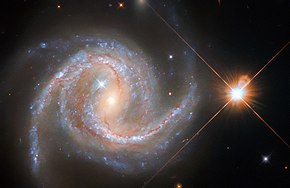NGC 5495
| NGC 5495 | |
|---|---|
 NGC 5495 imaged by the Hubble Space Telescope | |
| Observation data (J2000 epoch) | |
| Constellation | Hydra |
| Right ascension | 14h 12m 23s |
| Declination | -27° 06’ 29” |
| Redshift | 0.022472 |
| Heliocentric radial velocity | 6,737 km/s |
| Distance | 336 Mly (103.8 Mpc) |
| Apparent magnitude (V) | 13.5 |
| Apparent magnitude (B) | 13.53 |
| Surface brightness | 23.02 mag/arcsec^2 |
| Characteristics | |
| Type | SAc |
| Size | 259,000 ly (estimated 79.56 kpc) |
| Apparent size (V) | 1.5' x 1.2' |
| Other designations | |
| PGC 50729, ESO 510-10, IRAS 14095-2652, MCG -04-34-001, AM 1409-265 | |
NGC 5495 is a very large barred spiral galaxy located in the constellation Hydra.[1][2] Its speed relative to the cosmic microwave background is 6,989 ± 20 km/s, which corresponds to a Hubble distance of 103.1 ± 7.2 Mpc (∼336 million ly).[3][4] NGC 5495 was discovered by British astronomer John Herschel in 1834.
The luminosity class of NGC 5495 is III and it has a broad HI line. It also contains regions of ionized hydrogen, and is an active Seyfert 2 type galaxy.[3]
Additionally, NGC 5495 is known to host a megamaser.[5] There is further evidence it shows signs of H2O maser emission,[6] detected via 70m NASA Deep Space Network antennas in Australia and Spain. The source spectra in NGC 5495 is said to have an emission signature originating from its accretion disk with an orbital velocity of ~400 km s−1.[7]
The galaxy was selected as ESA/HUBBLE's Picture of the Week.[8]
See also
[edit]- Whirlpool Galaxy, another spiral galaxy with a similar shape
- List of NGC objects (5001–6000)
External links
[edit]References
[edit]- ^ "Astrovalley Field". astrovalleyfield.ca. Retrieved 2024-07-26.
- ^ "New General Catalog Objects: NGC 5450 - 5499". cseligman.com. Retrieved 2024-07-26.
- ^ a b "By Name | NASA/IPAC Extragalactic Database". ned.ipac.caltech.edu. Retrieved 2024-07-26.
- ^ "HyperLeda -object description". atlas.obs-hp.fr. Retrieved 2024-07-26.
- ^ Ramolla, M.; Haas, M.; Bennert, V. N.; Chini, R. (2011-06-01). "Megamaser detection and nuclear obscuration in Seyfert galaxies". Astronomy and Astrophysics. 530: A147. arXiv:1102.2419. Bibcode:2011A&A...530A.147R. doi:10.1051/0004-6361/201015247. ISSN 0004-6361.
- ^ Zhang, J. S.; Henkel, C.; Guo, Q.; Wang, H. G.; Fan, J. H. (2010-01-01). "On The Nuclear Obscuration of H2O Maser Galaxies". The Astrophysical Journal. 708 (2): 1528–1536. arXiv:0912.2159. Bibcode:2010ApJ...708.1528Z. doi:10.1088/0004-637X/708/2/1528. ISSN 0004-637X.
- ^ Kondratko, P. T.; Greenhill, L. J.; Moran, J. M.; Lovell, J. E. J.; Kuiper, T. B. H.; Jauncey, D. L.; Cameron, L. B.; Gómez, J. F.; García-Miró, C.; Moll, E.; de Gregorio-Monsalvo, I.; Jiménez-Bailón, E. (2006-02-01). "Discovery of Water Maser Emission in Eight AGNs with 70 m Antennas of NASA's Deep Space Network" (PDF). The Astrophysical Journal. 638 (1): 100–105. arXiv:astro-ph/0510851. Bibcode:2006ApJ...638..100K. doi:10.1086/498641. ISSN 0004-637X.
- ^ information@eso.org. "Hubble Spies a Stately Spiral Galaxy". www.esahubble.org. Retrieved 2024-07-26.
